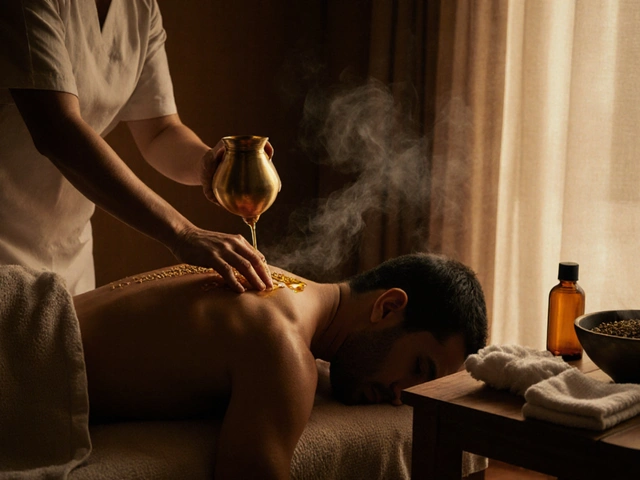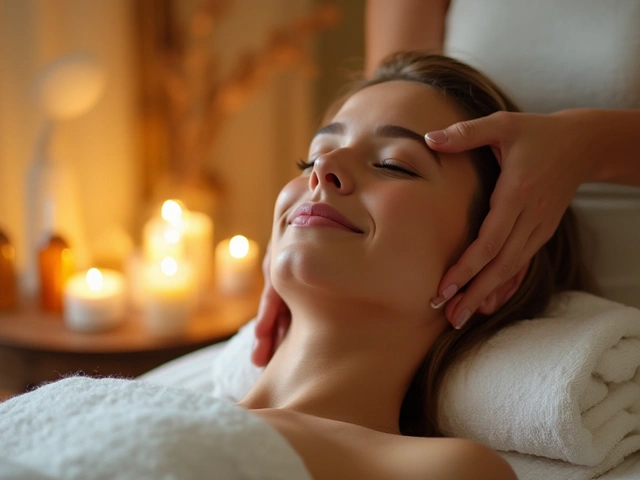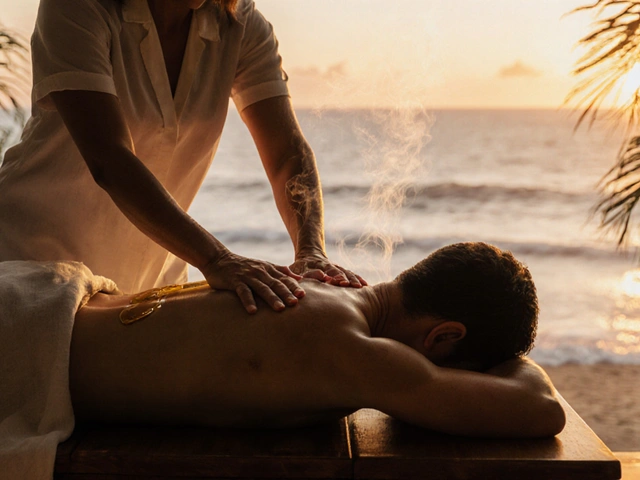Redefining Relaxation: How Stone Massage Heals Body and Mind
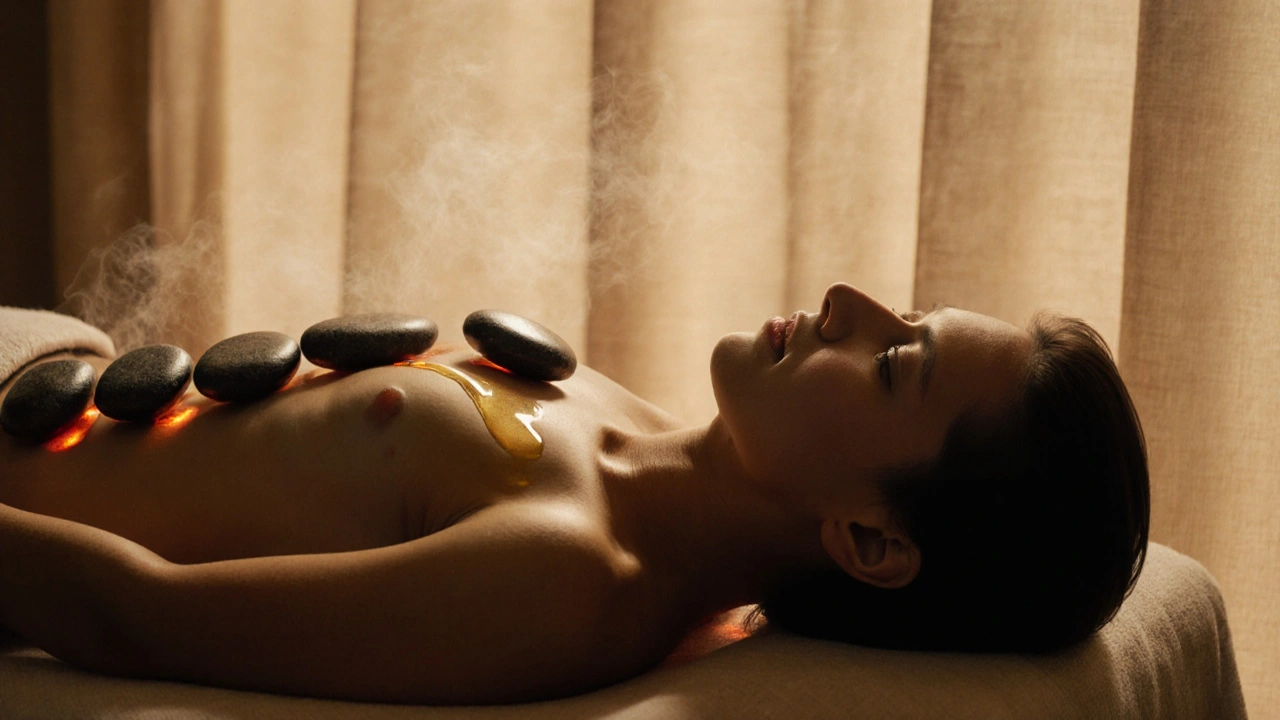
Stone Massage Suitability Assessment
Assess Your Stone Massage Suitability
This assessment helps determine if stone massage may be beneficial for your specific symptoms and health conditions based on medical guidelines.
Imagine lying down as warm stones, smooth and heavy, are placed along your spine, between your toes, and across your shoulders. The heat doesn’t just feel good-it sinks into your muscles like a quiet tide, loosening knots you didn’t even know you were holding. This isn’t fantasy. This is stone massage, and it’s been used for centuries across cultures-from ancient China to Native American traditions-to calm the nervous system, ease chronic pain, and bring deep, lasting relaxation.
What Exactly Is Stone Massage?
Stone massage, also called hot stone therapy, uses heated basalt stones-volcanic rock naturally rich in iron and perfect at holding heat-placed on specific points of the body. Sometimes, cold marble stones are added for contrast. The therapist may also hold the stones and use them like extensions of their hands, gliding them over your skin with oil. The heat penetrates deeper than traditional massage, reaching muscles that are tight, sore, or frozen from stress.
Unlike a standard Swedish or deep tissue massage, stone massage doesn’t rely on pressure alone. It uses temperature to trigger a physiological response: your blood vessels dilate, circulation improves, and your parasympathetic nervous system kicks in. That’s the part of your nervous system responsible for rest, digestion, and recovery. In short, your body doesn’t just feel relaxed-it starts healing.
Why Heat Makes All the Difference
Heat is one of the oldest and most effective pain relievers humans have ever used. But with stone massage, it’s not just about warmth-it’s about controlled, sustained heat. Basalt stones retain heat for 45 to 60 minutes at a steady 50-55°C (122-131°F), which is warm enough to relax tissue but safe enough to avoid burns when handled properly.
Studies from the Journal of Bodywork and Movement Therapies show that heat therapy reduces muscle spasm by up to 40% in people with chronic lower back pain. When you add the rhythmic motion of massage on top of that, the effect multiplies. People with fibromyalgia, arthritis, or even anxiety report feeling lighter, calmer, and more mobile after just one session.
And here’s something most people don’t realize: cold stones aren’t just for contrast. When placed on inflamed areas-like a swollen joint or a recent injury-they reduce swelling by constricting blood vessels. The shift from hot to cold tells your body to reset its pain signals. It’s like hitting a soft reset button on your nervous system.
Where Stones Are Placed-and Why
Stone massage isn’t random. The placement follows energy pathways and muscle groups tied to relaxation and recovery.
- Along the spine: Calms the central nervous system and relieves tension from sitting all day.
- On the palms and soles: Grounds the body, reduces anxiety, and improves sleep.
- Over the abdomen: Soothes digestive discomfort and eases menstrual cramps.
- On the forehead and temples: Eases headaches and quietens mental chatter.
- Between the shoulder blades: Releases the most common area of stored stress in modern life.
These aren’t just pressure points-they’re gateways. When heat reaches these areas, it signals your brain: “You’re safe now.” That’s why people often drift into a deep, dreamlike state during a session. Some even fall asleep. Others cry. It’s not weakness. It’s your body releasing what it’s been holding onto for months-or years.
Who Benefits Most From Stone Massage?
You don’t need to be injured or in pain to benefit. But some people feel the difference more intensely:
- Office workers with stiff necks and frozen shoulders from hunching over screens
- Parents juggling kids, jobs, and sleepless nights
- People with anxiety, PTSD, or depression who struggle to relax
- Athletes recovering from training or injury
- Seniors with arthritis or circulation issues
- Anyone who says, “I just can’t switch off”
One client in Auckland, a nurse working 12-hour shifts, came in after six months of insomnia. After three weekly stone massage sessions, she started sleeping through the night. “It wasn’t just the stones,” she told me. “It was the feeling that someone was finally holding space for me to just… be.”
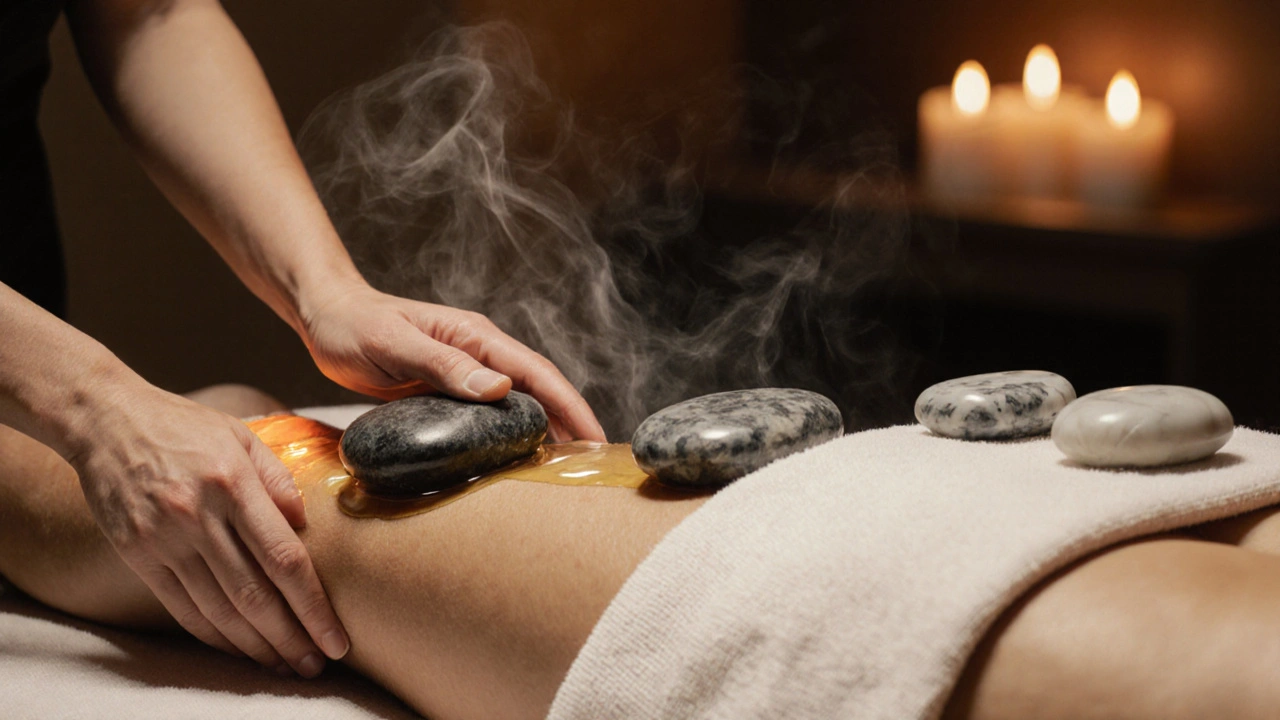
What to Expect in Your First Session
Most sessions last 60 to 90 minutes. You’ll lie on a heated table, covered with towels. The therapist will warm the stones in water (never microwaved) and test them on their own skin before placing them on you. You’ll feel the heat immediately-but it shouldn’t burn. If it does, speak up. Good therapists check in constantly.
You’ll be asked to breathe deeply. Don’t fight it. Let the warmth melt your jaw, your fists, your shoulders. After the stones are placed, the therapist will begin massaging with their hands, using the stones as tools. You might feel them roll over your back, glide down your legs, or rest gently on your chest.
At the end, you’ll be wrapped in a warm blanket. Many people feel light-headed or emotional afterward. That’s normal. Drink water. Don’t rush. Give yourself 20 minutes to come back to yourself before driving or heading into a meeting.
Stone Massage vs. Other Therapies
How does it stack up against other treatments?
| Therapy | Heat Use | Depth of Muscle Penetration | Stress Reduction | Best For |
|---|---|---|---|---|
| Stone Massage | Yes, sustained heat | Deep (up to 5 cm) | Very High | Chronic tension, anxiety, poor circulation |
| Swedish Massage | No | Superficial to medium | Moderate | General relaxation, light soreness |
| Deep Tissue Massage | No | Deep | Moderate | Scar tissue, athletic recovery |
| Hot Tub Soak | Yes, whole body | Shallow | Moderate | General warmth, mild stiffness |
| Yoga or Meditation | No | N/A | High (mental) | Mindfulness, long-term stress management |
Stone massage sits in a sweet spot. It’s not as intense as deep tissue, but it goes deeper than Swedish. It’s not a substitute for meditation, but it creates the physical calm that makes meditation easier. And unlike a hot tub, it’s targeted, guided, and therapeutic-not just a soak.
What to Avoid
Stone massage isn’t for everyone. Skip it if you:
- Have open wounds, burns, or recent surgery
- Have diabetes with poor sensation (risk of unnoticed burns)
- Are pregnant without clearance from your provider
- Have severe osteoporosis or blood clotting disorders
- Have a fever or active infection
Also, avoid alcohol or heavy meals right before. And don’t expect instant miracles. One session can feel amazing, but real change builds over time. Three sessions spaced a week apart is the sweet spot for most people.

Bringing Stone Massage Home
You don’t need a spa to experience the benefits. You can start small:
- Buy two smooth basalt stones (available online or at wellness stores) and heat them in warm water.
- Place one under your lower back while lying on the floor.
- Hold another in each hand while breathing slowly for 10 minutes.
- Use a heated rice sock as a DIY alternative-it’s not the same, but it helps.
Some people keep a stone on their nightstand and hold it before bed. It becomes a ritual: cool to the touch at first, then warm from your hand. A quiet anchor in a noisy day.
Why This Isn’t Just Another Spa Trend
Stone massage isn’t new. It’s ancient. But today, it’s more relevant than ever. We live in a world that never stops demanding our attention. Our bodies are wired to rest, but we’ve trained ourselves to ignore the signals. Stone massage doesn’t ask you to fix anything. It just asks you to lie still-and let heat do the work.
It’s not about luxury. It’s about relearning how to be human. How to let go. How to receive care without earning it. How to rest without guilt.
That’s the real power of stone massage. Not the heat. Not the stones. But the permission it gives you to stop.
Is stone massage painful?
No, it shouldn’t be. The heat relaxes muscles before the therapist applies pressure, so most people describe it as deeply soothing. If you feel sharp pain or burning, tell your therapist immediately. Good stone massage feels like a warm hug for your muscles.
How often should I get a stone massage?
For general relaxation, once a month is great. If you’re dealing with chronic pain, stress, or insomnia, try once a week for three weeks, then reduce to every two weeks. Many people find they need less frequent sessions over time as their body learns to relax more easily.
Can I do stone massage myself?
Yes, but with limits. You can use heated stones for self-care-like placing them on your back or holding them in your hands. But you can’t reach all areas effectively, and you won’t get the full therapeutic benefit of a trained therapist’s touch and pressure. Think of it like yoga: you can stretch alone, but a class gives you alignment and feedback.
Do the stones need to be special?
Yes. Basalt stones are ideal because they’re dense, smooth, and hold heat well. Avoid river rocks or decorative stones-they can crack, have sharp edges, or retain heat unevenly. Always buy from a trusted wellness supplier.
Is stone massage safe during pregnancy?
Yes, but only with a therapist trained in prenatal massage. Heat should be kept moderate, and stones should never be placed on the abdomen or lower back in early pregnancy. Always check with your doctor first.
How long do the effects last?
The immediate relaxation lasts 24 to 48 hours. But the deeper benefits-better sleep, reduced muscle tension, lower stress hormones-build over time. After three sessions, many people report lasting improvements in mood and energy that stick for weeks.
Next Steps: Try It
Find a licensed massage therapist who specializes in stone massage. Ask if they use basalt stones, how they heat them, and whether they’ve trained in therapeutic techniques-not just spa-style treatments. A good therapist will ask about your pain points, your stress levels, and your goals before starting.
Don’t treat this like a luxury. Treat it like medicine. Because for many, it is.

